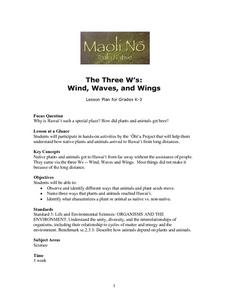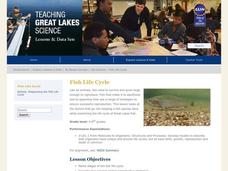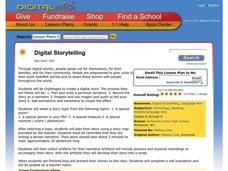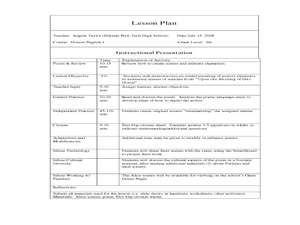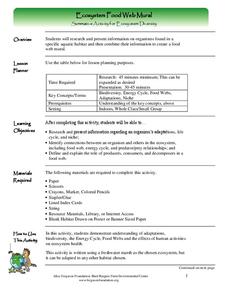Curated OER
Invertebrates and Vertebrate Evolution
Learners explore the major characteristics of the major animal phyla. They describe adaptive features that have contributed to the success of animals on land. Students explain how primate evolution provides a context for understanding...
Curated OER
Carnival of the Animals
First graders make a book that shows the different musical pieces in Carnival of the Animals that represent animals. In this animals and music lesson plan, 1st graders tell how they interpreted each part to represent an animal.
Curated OER
DNA: The Search for the Genetic Material
Students study the history of DNA and how to extract it. In this genetic activity students complete a DNA experiment using bacteria.
Curated OER
Natural Figures
First graders look for geometrical shapes in nature to help them appreciate the diversity of the natural environment.
Curated OER
The Three W's: Wind, Waves, and Wings
Students participate in hands-on acticities to understand how native plants and animals arrived on Hawaii from long distances without the assistance of man. They then identify what characterizes a plant or animal as native vs. non-native.
Michigan Sea Grant
Fish Life Cycle
Fish are no different when it comes to a living being's primary objective—to reproduce. They do differ, including from fish species to fish species, in their life cycles, survival tactics and reproductive strategies. After discussion of...
Curated OER
Natural History of Costa Rica
Students use outline maps to become acquainted with Costa Rica. They see how it was formed and how its origin has created very diverse environments. Students then use atlases and compare their physical maps with maps of climate and the...
Curated OER
Digital Storytelling
Students write a personal narrative and convert the story into digital format. In this digital storytelling lesson, students write a personal narrative, record the story, create images for the story, add animations or transitions, and...
Curated OER
African American Traditions: Cameroonian and African-American Folktales
High schoolers compare Cameroonian and African-American folktales. In this folktales lesson plan, students participate in a jigsaw activity that requires them to read "The Owl Never Sleeps as Night," "Why the Lizard Often Nods," "Tappin,...
Curated OER
Building a Clay Neuron
Students investigate and then build neurons in this lesson. They are examined as key parts of the brain and nervous system and seen as different from normal cells.
Alabama Learning Exchange
It's a Small, Small World
Learners compare and contrast the different characteristics of animal-like, plant-like, and fungus-like protists. They list examples and describe the characteristics shared by the three protist groups. They create a brochure or slideshow...
Curated OER
The Intertidal Zone
Students research the diverse animal and plant life that inhabit the intertidal zones along the Pacific rocky coast. As students progress through this lesson, they begin to recognize distinct behaviors, adaptations, and characteristics...
Curated OER
Different Types Of Bugs
First graders create their own bug that contain the different characteristics that a bug can have. In this bugs lesson plan, 1st graders first list 3 - 5 characteristics before they create their bug.
Curated OER
Water Quality and Dissolved Oxygen
Students investigate the relationship between dissolved oxygen and organic materials and aquatic organisms. This is a 3-instructional activity series in which students explore dissolved oxygen and then design an experiment testing the...
Curated OER
Louisiana Cinquains
Young scholars enhance their understanding of parts of speech by writing a cinquain poem about Louisiana. In this cinquain poem lesson plan, students read example cinquain poems and study the format for a cinquain poem. Young scholars...
Curated OER
Upon the Burning of Our House
Tenth graders read the poem "Upon the Burning of Our House" and complete analysis activities. In this poetry analysis lesson, 10th graders read the poem and create original scenes summarizing the stanza.
Curated OER
Geometry Gymnastics
Students identify shapes and manipulate 2 and 3 dimensional objects. They view objects from different perspectives and review relative positions (near, far, between). They sing a shape song.
Curated OER
Big Fleas Have Little Fleas!
Learners study seamounts and learn the importance of structures to species. For this ocean explorer lesson, students participate in an activity that teaches them how to modify a seamount so that they are more suitable for...
Curated OER
The Science of Weather: Hurricanes
Students use this USA today activity to learn about hurricane season. In this hurricane lesson plan, students study the map of the earth and hurricane science. Students complete discuss questions. Students draw a map of the United States...
Curated OER
Word Play
Students examine the Japanese folktale, Monkeys Grasp for the Moon. In this multicultural literature lesson, students discuss the theme of the folktale. Students choose animal folktales from other Asian cultures for comparison.
Curated OER
Norman Suburban Activity
Students analyze the factors affecting organisms in the pond ecosystem. In this environmental science instructional activity, students perform an experiment to determine pH, nutrients and temperature of different pond sites. They present...
Curated OER
Desert Views - First Impressions: Travelers on the Gila Trail
Students draw animals and plants that are described to them as they read passages of people who traveled across the Gila Trail in the Southwest. In this Gila Trail lesson plan, students also write a letter describing a plant or animal in...
Curated OER
Ecosystem Food Web Mural
Learners create a food web mural about an ecosystem of the freshwater marsh. For this food web lesson plan, pupils write about the organisms and how each one depends on another.
Curated OER
Creative Classification
Students create an animal by using physical characteristics to classify that animal in the Linnaean Classification System. This lesson plan is part of a multi-segmented unit on the diversity of life.






